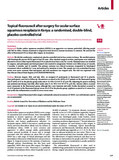| dc.description.abstract | Background
Ocular surface squamous neoplasia (OSSN) is an aggressive eye tumour particularly affecting people with HIV in Africa. Primary treatment is surgical excision; however, tumour recurrence is common. We assessed the effect of fluorouracil 1% eye drops after surgery on recurrence.
Methods
We did this multicentre, randomised, placebo-controlled trial in four centres in Kenya. We enrolled patients with histologically proven OSSN aged at least 18 years. After standard surgical excision, participants were randomly allocated to receive either topical fluorouracil 1% or placebo four times a day for 4 weeks. Randomisation was stratified by surgeon, and participants and trial personnel were masked to assignment. Patients were followed up at 1 month, 3 months, 6 months, and 12 months. The primary outcome was clinical recurrence (supported by histological assessment where available) by 1 year, and analysed by intention to treat. The sample size was recalculated because events were more common than anticipated, and trial enrolment was stopped early. The trial was registered with Pan-African Clinical Trials Registry (PACTR201207000396219).
Findings
Between August, 2012, and July, 2014, we assigned 49 participants to fluorouracil and 49 to placebo. Four participants were lost to follow-up. Recurrences occurred in five (11%) of 47 patients in the fluorouracil group and 17 (36%) of 47 in the placebo group (odds ratio 0·21, 95% CI 0·07–0·63; p=0·01). Adjusting for passive smoking and antiretroviral therapy had little effect (odds ratio 0·23; 95% CI 0·07–0·75; p=0·02). Adverse effects occurred more commonly in the fluorouracil group, although they were transient and mild. Ocular discomfort occurred in 43 of 49 patients in the fluorouracil group versus 36 of 49 in the placebo group, epiphora occurred in 24 versus five, and eyelid skin inflammation occurred in seven versus none.
Interpretation
Topical fluorouracil after surgery substantially reduced recurrence of OSSN, was well-tolerated, and its use recommended.
Funding
British Council for Prevention of Blindness and the Wellcome Trust. | en_US |



